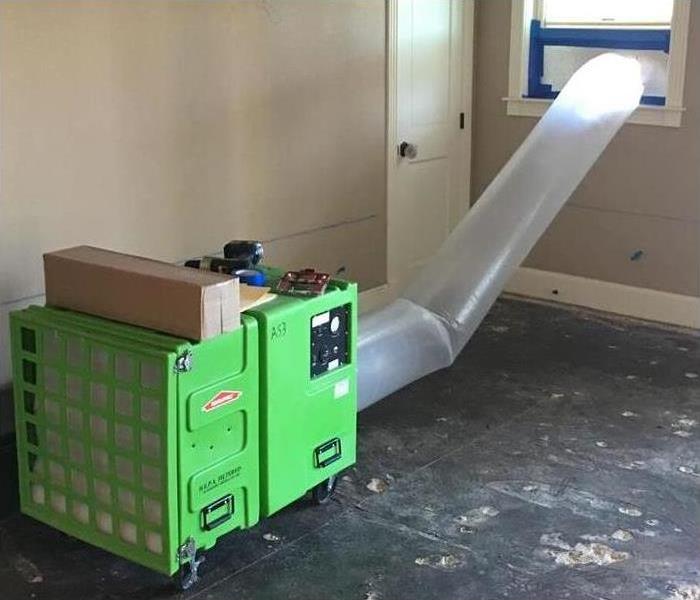How Does SERVPRO Prepare to Handle Fire Damage in My Home?
9/21/2020 (Permalink)
 SERVPRO uses advanced equipment like this air scrubber with negative air pressure to improve IAQ indoor air quality after a fire in a Syosset home
SERVPRO uses advanced equipment like this air scrubber with negative air pressure to improve IAQ indoor air quality after a fire in a Syosset home
Syosset Homeowners Need a Fire Damage Crew They Can Rely On
Staying organized is key to getting everything done. Whether you're trying to keep up with projects at work or finish planning Aunt Muriel's birthday meal, staying organized is a must. The same is true for any Syosset home projects. And although you might not have thought about it before, the same is true of restoration crews.
If you need help with fire damage to your Syosset home, you want to know the attending crew is well organized. It is not enough to understand how to remediate smoke and soot damage. Preparation and organization are essential for an effective service.
Who is involved in fire damage restoration?
Fire damage restoration is a complex project with many moving parts. There may be multiple areas of your home that need attention. For example, the walls might need soot removal, while the site closest to the blaze requires the ceiling repaired. There will be several team members on-site, too, including:
- A project manager who is responsible for devising the best plan of action for your home
- A crew chief who is responsible for executing that plan as safely, quickly, and effectively as possible
- The restoration team who carries out remediation tasks and puts your home back "Like it never even happened."
What kind of preparation do remediation specialists need?
You would not go on a road trip without ensuring you had enough fuel for your vehicle and snacks for the journey. SERVPRO of Hicksville / Plainview does not leave for your home without making thorough preparations, including:
- A plan of which rooms need cleaning if any places are off-limits, and how we are going to handle the contents of each room (cleaning in situ, or removal)
- A briefing to make sure each team member knows what is expected of them that day
- A list of any equipment required beyond the standard fire restoration equipment, such as extra high ladders or additional personal protective equipment
These things are just as important as our restoration equipment. We also assess each SERVPRO crew member's strengths to pair technicians in the most efficient way.
What happens when the technicians arrive?
We start with a walk-through of your property. Doing this allows us to spot any additional issues that have arisen since we last spoke with you.
The next step is to set up a staging area before beginning restoration activities. A staging area keeps everything we need in one place and stops our workspace from becoming cluttered. It also minimizes how often our technicians have to walk through other parts of your home than the one they are working on.
What happens after you set up the staging area?
The next step is contents management. We can clear a space where we do our work – sometimes this is by moving your belongings around, sometimes it is by performing a pack-out and removing your items to our warehouse.
If we are doing a pack-out, we will carefully inventory your contents before moving them. Our CCIS Contents Claim Inventory System program simplifies and documents our coordination with you and your insurance company. We work on one small area at a time, moving contents in preparation for cleaning.
If any part requires controlled demolition (such as a sagging ceiling or burnt-out wall), we do that before cleaning. When everything is prepared, we can begin cleaning.
What can SERVPRO clean?
We train our team to the Institute of Inspection, Cleaning and Restoration Certification (IICRC) standards. They will assess the damage and decide on the best cleaning method. For example, we can use:
- Dry scrubbing and HEPA vacuuming to get rid of dry soot particles
- Wet cleaning and foam cleaners to handle more stubborn stains
- Baking soda blasting for crawl spaces, attics, and basements
- Spot cleaning for delicate upholstery
- Dry cleaning and ultrasonic cleaning for items that cannot withstand wet cleaning
We generally clean rooms top to bottom, starting at the ceiling. Preparation and organization are essential during cleaning too. We make sure our technicians have a clear plan of what to clean, which method to use, and in which order to carry out cleaning tasks.
What happens after cleaning?
When your home is clean, we deodorize it. We know lingering smoke odors are very unpleasant. We have a range of deodorization options, including air scrubbers, wet fogging, and ozone generators. Our teams emphasize thorough cleaning to remove the odor's source, but extra deodorization is sometimes needed.
If we removed your contents, we will bring them back and set them up in their respective places.
For help from a well-prepared fire damage restoration team, call SERVPRO of Hicksville / Plainview at (516) 733-1800.






 24/7 Emergency Service
24/7 Emergency Service